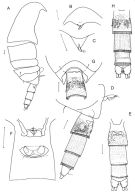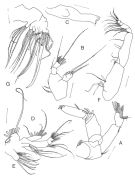|
|
 |
Fiche d'espèce de Copépode |
|
|
Calanoida ( Ordre ) |
|
|
|
Clausocalanoidea ( Superfamille ) |
|
|
|
Phaennidae ( Famille ) |
|
|
|
Brachycalanus ( Genre ) |
|
|
| |
Brachycalanus flemingeri Ferrari & Markhaseva, 2000 (F) | |
| | | | | | | Ref.: | | | Ferrari & Markhaseva, 2000 a (p.1065, Descr.F, figs.F); Bradford-Grieve, 2004 b (p.645, tab.2) |  issued from : F.D. Ferrari & E.L. Markhaseva in Proc. Biol. Soc. Washington, 2000, 113 (4). [p.1066, Fig.1]. Female (from off Kona, Hawaï): A, habitus (lateral right side); B, forehead (ventral); C, rostrum (anterior-ventral); D, posterior part of cephalothorax and urosome (lateral right side); E, urosome (ventral); F, genital complex (ventral); G, posterior part of cephalothorax and genital complex; H, urosome (dorsal). Bars: 0.1 mm. Nota: Head and 1st thoracic segment separate, 4th and 5th separated but not well articulated. 3rd thoracic segment with 2 sensilla laterally, ventrallonger; 4th with 1 short dorsal sensilla laterally. genital segment and following 2 urosomal segments with small, scale-like spinules. Rostrum, subdiivided plate with 2 filaments. A1 (24-segmented) reaching the 2nd thoracic segment. Caudal rami with 4 large, terminal setae, 1 small medial-dorsal seta, and 1 small lateral-ventral seta. For the authors the true first thoracic somite is corresponding to Mxp in the publication as the genital complex incoporates the last thoracic somite and the first urosomal somite (= genital complex).
|
 issued from : F.D. Ferrari & E.L. Markhaseva in Proc. Biol. Soc. Washington, 2000, 113 (4). [p.1068, Fig.2]. Female: A, A2 (ventral); B, Md (mandibular palp), dorsal; C, Md (mandibular blade = gnathobase); D, Mx1 (anterior); E, Mx1 (praecoxal lobe, posterior, distal down); F, Mxp (anterior); G, Mx2 (anterior). Bars: 0.1 mm. Nota: Mx1 with praecoxa with 9 terminal, 1 anterior and 4 posterior setae; coxal epipodite with 1 thin, short seta and 8 long, thick setae; coxal endite with 3 setae; 1st and 2nd basal endites with 4 and 5 setae respectively. endopod with 11 setae (3+3+5); exopod with 10 setae. Mx2 with proximal praecoxal endite with 5 setae, distal with 3 setae (1 poorly sclerotized); proximal coxal endite with 1 short, poorly sclerotized sensory seta and 2 long well-sclerotized setae; distal coxal endite with 1 thick and 2 thin setae; proximal basal endite with 1 long, thick seta, 1 long, thin seta and 2 poorly sclerotized sensoru setae; diatal basal lobe + exopod with 9 sensory setae, 7 brush-like sensory setae with short setules and 2 worm-like setae (1 of which is bifurcate toward its distal end).
|
 issued from : F.D. Ferrari & E.L. Markhaseva in Proc. Biol. Soc. Washington, 2000, 113 (4). [p.1069, Fig.3]. Female: A, P1 (anterior); B, P1 (posterior); C, P2 (coxa, basis and endopod, posterior); D, P2 (exopod, medial seta of proximal segment missing, posterior); E, P3 ( distal exopodal segment missing), posterior; F, P3 (distal segment), posterior); G, left P4 (middle and distal segments of exopod, posterior); H, right P4 (basis and endopod, posterior); I, left P4 (coxa, basis and proximal ramal segments, posterior, medial seta of proximal exopodal segment missing); J, P5 (posterior). Bars: 0.1 mm.
| | | | | Ref. compl.: | | | Bradford-Grieve, 2004 (p.284) | | | | NZ: | 1 | | |
|
Carte de distribution de Brachycalanus flemingeri par zones géographiques
|
| | | | Loc: | | | N Pacif. (off S Hawaii: off Kona) | | | | N: | 1 | | | | Lg.: | | | (822) F: 2,37-2,01; {F: 2,01-2,37} | | | | Rem.: | depth: 675 m. | | | Dernière mise à jour : 02/05/2018 | |
|
|
 Toute utilisation de ce site pour une publication sera mentionnée avec la référence suivante : Toute utilisation de ce site pour une publication sera mentionnée avec la référence suivante :
Razouls C., Desreumaux N., Kouwenberg J. et de Bovée F., 2005-2025. - Biodiversité des Copépodes planctoniques marins (morphologie, répartition géographique et données biologiques). Sorbonne Université, CNRS. Disponible sur http://copepodes.obs-banyuls.fr [Accédé le 03 décembre 2025] © copyright 2005-2025 Sorbonne Université, CNRS
|
|
 |
 |






